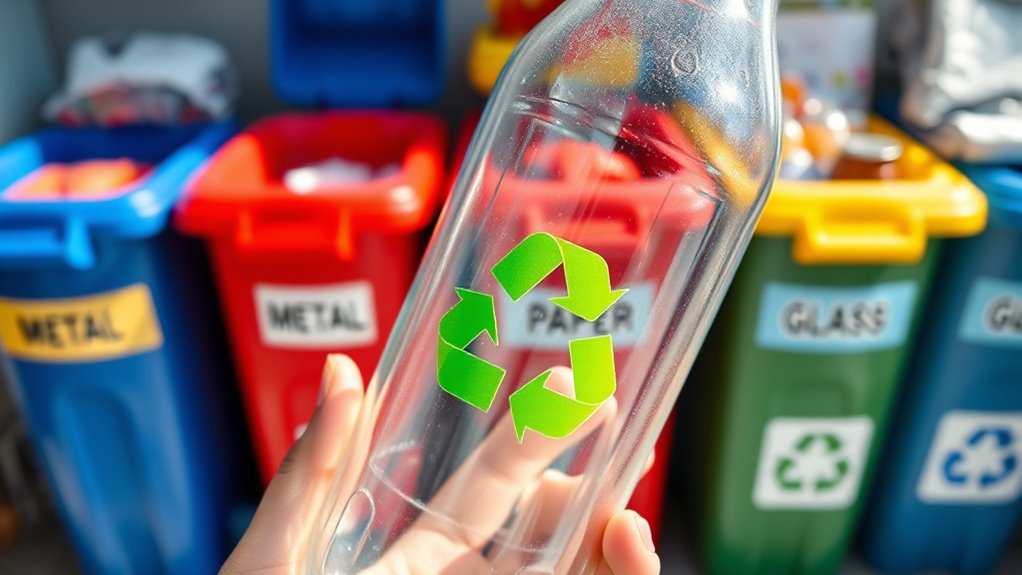To understand recycling symbols, look for the Mobius loop and specific plastic codes like PETE or HDPE, which tell you if an item is recyclable. Pay attention to numbers inside symbols, as they identify plastic types and guide proper disposal. Be aware of additional symbols for compostable or biodegradable materials. Check your local guidelines for specific rules, and familiarizing yourself with these symbols will help you recycle correctly and reduce waste. If you want to learn more, continue exploring how these symbols can make your recycling easier.
Key Takeaways
- Recognize the Mobius loop and specific resin codes (1-7) to identify recyclable plastics properly.
- Check local recycling guidelines, as not all symbols are accepted everywhere.
- Pay attention to additional symbols indicating compostable, biodegradable, or special plastic types.
- Develop habits to quickly spot recycling symbols and differentiate recyclable from non-recyclable items.
- Consult municipal or authoritative resources for detailed symbol meanings and proper disposal practices.

Have you ever wondered what those symbols on plastic bottles and packaging really mean? Most likely, you’ve seen a triangle of arrows with a number inside, or maybe other symbols that seem confusing at first glance. These are known as recycling symbol variations, and understanding them is essential to recycling correctly. Recognizing these symbols isn’t always straightforward, but by using simple symbol recognition techniques, you can quickly identify how to dispose of each item properly. The first step is to familiarize yourself with common recycling symbols, starting with the Mobius loop, which indicates that the item is recyclable. However, not all items with this symbol are recyclable everywhere, so it’s important to check your local guidelines. Some packaging might display additional symbols that specify the type of plastic, like PETE (polyethylene terephthalate) or HDPE (high-density polyethylene), informing you about the material’s recycling process. These variations help you distinguish between plastics that can be easily recycled and those that require special handling or should be avoided altogether. Additionally, understanding the recycling symbols can help you make more eco-conscious choices and reduce contamination in recycling streams. To decode these symbols efficiently, you should develop a few symbol recognition techniques. For example, pay close attention to the number inside the recycling triangle—numbers 1 through 7 indicate different plastics, each with its own recycling rules. Recognizing these numbers quickly can prevent you from mistakenly disposing of non-recyclables with recyclable items. Also, look for additional symbols like the resin identification code, which often appears alongside the main recycling symbol, guiding you to the right recycling bin. Some packaging might feature symbols indicating whether an item is compostable or biodegradable, which is indispensable information for eco-conscious disposal. Furthermore, being aware of recycling label variations can help you better understand different symbols and their meanings, making your recycling efforts more accurate. Developing a habit of checking for recycling instructions on packaging can also streamline your sorting process, ensuring you’re recycling correctly. Using resources like recycling guidelines provided by local authorities can further clarify any uncertainties. When in doubt, check your local recycling guidelines or visit municipal websites to confirm what each symbol signifies in your area.
Frequently Asked Questions
How Do I Recycle Electronics Safely?
To recycle electronics safely, you should focus on proper e-waste disposal and electronics recovery. Start by finding certified e-waste collection centers or programs in your area and avoid throwing gadgets in regular trash. Before recycling, wipe personal data and remove batteries if possible. This guarantees your data stays private and your electronics are properly processed, minimizing environmental impact. Following these steps helps protect both your privacy and the planet.
What Materials Are Considered Hazardous Waste?
Hazardous waste is like a dangerous trail you don’t want to follow without proper gear. You need to identify materials such as paints, batteries, chemicals, and pesticides that fall under hazardous waste. Follow hazardous waste identification and chemical disposal guidelines to handle these safely. Proper disposal prevents harm to people and the environment, ensuring you stay on the safe path and avoid potential dangers lurking in hazardous materials.
How Can I Reduce Contamination in Recycling Bins?
To reduce contamination in your recycling bins, focus on recycling education and contamination prevention. Make sure you rinse and clean items so they don’t carry food residue or liquids, which can spoil recyclables. Always check local guidelines for accepted materials and avoid placing plastic bags or contaminated items in the bin. Educate yourself and others about proper recycling practices to keep the process efficient and eco-friendly, preventing contamination effectively.
Are Biodegradable Plastics Recyclable?
Biodegradable plastics aren’t always recyclable because their recycling compatibility depends on local facilities. You might think they can go in regular recycling bins, but many recycling centers can’t process them properly. To avoid contamination, check with your local recycling program before tossing biodegradable plastics in the bin. If they aren’t accepted, dispose of them in the compost or trash. Always verify what plastics your community can recycle to help protect the environment.
How Do Local Recycling Programs Differ Nationwide?
You’ll find that local recycling programs differ nationwide due to varying recycling regulations and collection schedules. Some areas may accept specific materials, while others don’t, so you need to verify your local guidelines. Collection schedules can also vary, with some communities offering weekly pickups and others bi-weekly or monthly. Staying informed about your area’s rules ensures you recycle correctly and helps reduce contamination in the recycling stream.
Conclusion
By recognizing recycling symbols, you can make smarter choices and reduce waste. Imagine tossing a plastic bottle with the recycling symbol in your bin, knowing it’ll be properly processed. For instance, a community that educates residents about symbols sees a 30% increase in recycling accuracy. When you understand these icons, you’re not just discarding items—you’re actively helping the planet. So, next time you recycle, remember: your small action makes a big difference.








